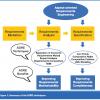Testing
Better Software Magazine Articles
 |
Quick, Before We Release Matt Heusser presents ten key factors to establish a team cadence—the time between running tests and getting a product into production. The shorter the cadence, the less time spent in test/fix/retest land, and the more time spent working on new features. |
|
 |
Building Mobile Apps the User Can Trust It seems like every week there's a new security disaster impacting millions of users worldwide. With the acceptance of mobile apps providing timely data at your fingertips, users are becoming very concerned about security. Philip gives you some impactful tips for developing apps that create trust with end-users. |
|
 |
You Can't Be Agile without Automated Unit Testing Agile projects assume that test planning, test creation, and test execution take place throughout a project's lifecycle. So the need for unit testing (and especially automated unit testing) can't be ignored and should be considered as a key responsibility of the entire team—not just the software developers. |
|
|
Learning For Agile Testers, Part 2 In part one of our Learning for Agile Testers series, we addressed general "thinking" skills that go beyond technical competence and how learning these enhances the value you contribute. In part two, we discuss some specific technical skills that benefit testers and how to acquire them. |
||
 |
How Do You Write Good User Stories? Expert answers to frequently asked questions. In this issue, David Hussman explains how to write good user stories. |
|
|
Busted: 5 Myths of Testing Regulated Software Testing regulated software is often seen as a tedious job that generates stacks of documentation and is subject to crippling rules. See five of these assumptions exposed as mere myths, and learn how regulated testers can use the same approaches, techniques, and tools at any other tester's disposal while still passing a process audit. |
John McConda
November 1, 2010 |
|
 |
Slicing Requirements for Agile Success Agile teams need to analyze product requirements in enough detail to build, test, and deliver the right requirements in short time frames. For the many teams that struggle to define "just enough, just in time” requirements, here's help. |
|
|
Selling To Your Buyer No matter how well you've built it, no users will benefit from your product unless you can convince the buyers to purchase it. Selling to buyers is different than satisfying users—and you have to do both well to succeed. Consider the needs of the buyer as stakeholder. When you have no buyers, you have no users. |
||
 |
Building a Foundation for Structured Requirements: Aspect-Oriented Requirements Engineering Explained (Part 2) Aspect-oriented requirements engineering (AORE) is a new methodology that can help us to further improve the analysis, structure, and cost of development of software requirements. The second part of this two-part series focuses on the AORE specification techniques. |
Yuri Chernak
February 26, 2009 |
 |
Building a Foundation for Structured Requirements: Aspect-Oriented Engineering Explained (Part 1) Aspect-oriented requirements engineering (AORE) is a new methodology that can help us improve the analysis, structure, and cost of development of software requirements. AORE does not replace but rather complements any of the existing requirements methodologies. This two-part paper explains to software practitioners the AORE concept, illustrates how it can be applied on software projects, and discusses the benefits of AORE. Part I focuses on the AORE analysis techniques. |
Yuri Chernak
December 30, 2008 |









